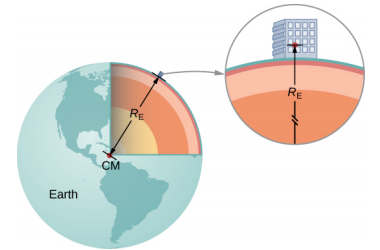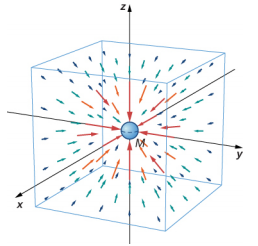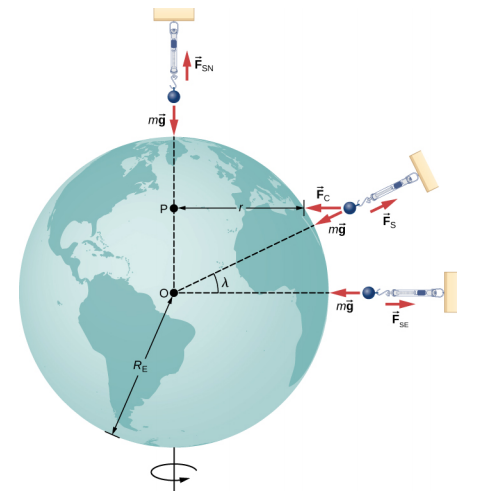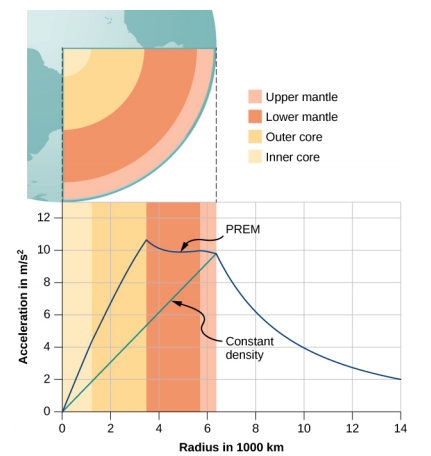6.2: Mass, Weight and Gravitation Near a Planet's Surface
( \newcommand{\kernel}{\mathrm{null}\,}\)
- Explain the difference between mass and weight
- Explain why falling objects on Earth are never truly in free fall
- Describe the concept of weightlessness
- Explain the connection between the constants G and g
- Determine the mass of an astronomical body from free-fall acceleration at its surface
- Describe how the value of g varies due to location and Earth’s rotation
Mass and weight are often used interchangeably in everyday conversation. For example, our medical records often show our weight in kilograms but never in the correct units of newtons. In physics, however, there is an important distinction. Weight is the pull of Earth on an object. It depends on the distance from the center of Earth. Unlike weight, mass does not vary with location. The mass of an object is the same on Earth, in orbit, or on the surface of the Moon, it depends on the amount of matter not on its location.
Units of Force
The equation Fnet = ma is used to define net force in terms of mass, length, and time. As explained earlier, the SI unit of force is the newton. Since Fnet = ma,
1N=1kg⋅m/s2.
Although almost the entire world uses the newton for the unit of force, in the United States, the most familiar unit of force is the pound (lb), where 1 N = 0.225 lb. Thus, a 225-lb person weighs 1000 N.
Weight and Gravitational Force
When an object is dropped, it accelerates toward the center of Earth. Newton’s second law says that a net force on an object is responsible for its acceleration. If air resistance is negligible, the net force on a falling object is the gravitational force, commonly called its weight →w, or its force due to gravity acting on an object of mass m. Weight can be denoted as a vector because it has a direction; down is, by definition, the direction of gravity, and hence, weight is a downward force. The magnitude of weight is denoted as w. Galileo was instrumental in showing that, in the absence of air resistance, all objects fall with the same acceleration g. Using Galileo’s result and Newton’s second law, we can derive an equation for weight.
Consider an object with mass m falling toward Earth. It experiences only the downward force of gravity, which is the weight →w. Newton’s second law says that the magnitude of the net external force on an object is →Fnet=m→a. We know that the acceleration of an object due to gravity is →g, or →a=→g. Substituting these into Newton’s second law gives us the following equations.
The gravitational force on a mass is its weight. We can write this in vector form, where →w is weight and m is mass, as
→w=m→g.
In scalar form, we can write
w=mg.
Since g = 9.80 m/s2 on Earth, the weight of a 1.00-kg object on Earth is 9.80 N:
w=mg=(1.00kg)(9.80m/s2)=9.80N.
When the net external force on an object is its weight, we say that it is in free fall, that is, the only force acting on the object is gravity. However, when objects on Earth fall downward, they are never truly in free fall because there is always some upward resistance force from the air acting on the object.
Acceleration due to gravity g varies slightly over the surface of Earth, so the weight of an object depends on its location and is not an intrinsic property of the object. Weight varies dramatically if we leave Earth’s surface. On the Moon, for example, acceleration due to gravity is only 1.67 m/s2. A 1.0-kg mass thus has a weight of 9.8 N on Earth and only about 1.7 N on the Moon.
The broadest definition of weight in this sense is that the weight of an object is the gravitational force on it from the nearest large body, such as Earth, the Moon, or the Sun. This is the most common and useful definition of weight in physics. It differs dramatically, however, from the definition of weight used by NASA and the popular media in relation to space travel and exploration. When they speak of “weightlessness” and “microgravity,” they are referring to the phenomenon we call “free fall” in physics. We use the preceding definition of weight, force →w due to gravity acting on an object of mass m, and we make careful distinctions between free fall and actual weightlessness.
Be aware that weight and mass are different physical quantities, although they are closely related. Mass is an intrinsic property of an object: It is a quantity of matter. The quantity or amount of matter of an object is determined by the numbers of atoms and molecules of various types it contains. Because these numbers do not vary, in Newtonian physics, mass does not vary; therefore, its response to an applied force does not vary. In contrast, weight is the gravitational force acting on an object, so it does vary depending on gravity. For example, a person closer to the center of Earth, at a low elevation such as New Orleans, weighs slightly more than a person who is located in the higher elevation of Denver, even though they may have the same mass.
It is tempting to equate mass to weight, because most of our examples take place on Earth, where the weight of an object varies only a little with the location of the object. In addition, it is difficult to count and identify all of the atoms and molecules in an object, so mass is rarely determined in this manner. If we consider situations in which →g is a constant on Earth, we see that weight →w is directly proportional to mass m, since →w=m→g, that is, the more massive an object is, the more it weighs. Operationally, the masses of objects are determined by comparison with the standard kilogram, as we discussed in Units and Measurement. But by comparing an object on Earth with one on the Moon, we can easily see a variation in weight but not in mass. For instance, on Earth, a 5.0-kg object weighs 49 N; on the Moon, where g is 1.67 m/s2, the object weighs 8.4 N. However, the mass of the object is still 5.0 kg on the Moon.
A farmer is lifting some moderately heavy rocks from a field to plant crops. He lifts a stone that weighs 40.0 lb. (about 180 N). What force does he apply if the stone accelerates at a rate of 1.5 m/s2?
Strategy
We were given the weight of the stone, which we use in finding the net force on the stone. However, we also need to know its mass to apply Newton’s second law, so we must apply the equation for weight, w = mg, to determine the mass.
Solution
No forces act in the horizontal direction, so we can concentrate on vertical forces, as shown in the following free-body diagram. We label the acceleration to the side; technically, it is not part of the free-body diagram, but it helps to remind us that the object accelerates upward (so the net force is upward).
w=mg
m=wg=180N9.8m/s2=18kg
∑F=ma
F−w=ma
F−180N=(18kg)(1.5m/s2)
F−180N=27N
F=207N=210N to two significant figures
Significance
To apply Newton’s second law as the primary equation in solving a problem, we sometimes have to rely on other equations, such as the one for weight or one of the kinematic equations, to complete the solution.
For 6.2.1, find the acceleration when the farmer’s applied force is 230.0 N
Weight on Any Planet
Recall that the acceleration of a free-falling object near Earth’s surface is approximately g = 9.80 m/s2. The force causing this acceleration is called the weight of the object, and from Newton’s second law, it has the value mg. This weight is present regardless of whether the object is in free fall. We now know that this force is the gravitational force between the object and Earth. If we substitute mg for the magnitude of →F12 in Newton’s law of universal gravitation, m for m1, and ME for m2, we obtain the scalar equation
mg=GmMEr2
where r is the distance between the centers of mass of the object and Earth. The average radius of Earth is about 6370 km. Hence, for objects within a few kilometers of Earth’s surface, we can take r=RE (Figure 6.2.1). The mass m of the object cancels, leaving
g=GMEr2.
This explains why all masses free fall with the same acceleration. We have ignored the fact that Earth also accelerates toward the falling object, but that is acceptable as long as the mass of Earth is much larger than that of the object.

Have you ever wondered how we know the mass of Earth? We certainly can’t place it on a scale. The values of g and the radius of Earth were measured with reasonable accuracy centuries ago.
- Use the standard values of g, RE, and Equation ??? to find the mass of Earth.
- Estimate the value of g on the Moon. Use the fact that the Moon has a radius of about 1700 km (a value of this accuracy was determined many centuries ago) and assume it has the same average density as Earth, 5500 kg/m3.
Strategy
With the known values of g and RE, we can use Equation ??? to find ME. For the Moon, we use the assumption of equal average density to determine the mass from a ratio of the volumes of Earth and the Moon.
Solution
- Rearranging Equation ???, we have ME=gR2EG=(9.80m/s2)(6.37×106m)26.67×10−11N⋅m2/kg2=5.95×1024kg.
- The volume of a sphere is proportional to the radius cubed, so a simple ratio gives us MMME=R3MR3E→MM=((1.7×106m)3(6.37×106m)3)(5.95×1024kg)=1.1×1023kg.We now use Equation ???. gM=GMMr2M=(6.67×10−11N⋅m2/kg2)(1.1×1023kg(1.7×106m)2)=2.5m/s2
Significance
As soon as Cavendish determined the value of G in 1798, the mass of Earth could be calculated. (In fact, that was the ultimate purpose of Cavendish’s experiment in the first place.) The value we calculated for g of the Moon is incorrect. The average density of the Moon is actually only 3340 kg/m3 and g = 1.6 m/s2 at the surface. Newton attempted to measure the mass of the Moon by comparing the effect of the Sun on Earth’s ocean tides compared to that of the Moon. His value was a factor of two too small. The most accurate values for g and the mass of the Moon come from tracking the motion of spacecraft that have orbited the Moon. But the mass of the Moon can actually be determined accurately without going to the Moon. Earth and the Moon orbit about a common center of mass, and careful astronomical measurements can determine that location. The ratio of the Moon’s mass to Earth’s is the ratio of [the distance from the common center of mass to the Moon’s center] to [the distance from the common center of mass to Earth’s center].
Later in this section, we will see that the mass of other astronomical bodies also can be determined by the period of small satellites orbiting them. But until Cavendish determined the value of G, the masses of all these bodies were unknown.
What is the value of g 400 km above Earth’s surface, where the International Space Station is in orbit?
Solution
Using the value of ME and noting the radius is r = RE + 400 km, we use Equation ??? to find g. From Equation ??? we have
g=GMEr2=(6.67×10−11N⋅m2/kg2)(5.96×1024kg(6.37×106+400×103m)2)=8.67m/s2.
Significance
We often see video of astronauts in space stations, apparently weightless. But clearly, the force of gravity is acting on them. Comparing the value of g we just calculated to that on Earth (9.80 m/s2) , we see that the astronauts in the International Space Station still have 88% of their weight. They only appear to be weightless because they are in free fall. We will come back to this in Satellite Orbits and Energy.
How does your weight at the top of a tall building compare with that on the first floor? Do you think engineers need to take into account the change in the value of g when designing structural support for a very tall building?
The Gravitational Field
Equation ??? is a scalar equation, giving the magnitude of the gravitational acceleration as a function of the distance from the center of the mass that causes the acceleration. But we could have retained the vector form for the force of gravity in Equation ???, and written the acceleration in vector form as
→g=GMr2ˆr.
We identify the vector field represented by →g as the gravitational field caused by mass M. We can picture the field as shown Figure 6.2.2. The lines are directed radially inward and are symmetrically distributed about the mass.

As is true for any vector field, the direction of →g is parallel to the field lines at any point. The strength of →g at any point is inversely proportional to the line spacing. Another way to state this is that the magnitude of the field in any region is proportional to the number of lines that pass through a unit surface area, effectively a density of lines. Since the lines are equally spaced in all directions, the number of lines per unit surface area at a distance r from the mass is the total number of lines divided by the surface area of a sphere of radius r, which is proportional to r 2 . Hence, this picture perfectly represents the inverse square law, in addition to indicating the direction of the field. In the field picture, we say that a mass m interacts with the gravitational field of mass M. We will use the concept of fields to great advantage in the later sections on electromagnetism.
Apparent Weight: Accounting for Earth’s Rotation
As we saw in Applications of Newton’s Laws, objects moving at constant speed in a circle have a centripetal acceleration directed toward the center of the circle, which means that there must be a net force directed toward the center of that circle. Since all objects on the surface of Earth move through a circle every 24 hours, there must be a net centripetal force on each object directed toward the center of that circle.
Let’s first consider an object of mass m located at the equator, suspended from a scale (Figure 6.2.3). The scale exerts an upward force →Fs away from Earth’s center. This is the reading on the scale, and hence it is the apparent weight of the object. The weight (mg) points toward Earth’s center. If Earth were not rotating, the acceleration would be zero and, consequently, the net force would be zero, resulting in Fs = mg . This would be the true reading of the weight.

With rotation, the sum of these forces must provide the centripetal acceleration, ac. Using Newton’s second law, we have
∑F=Fs−mg=macwhereac=−v2r.
Note that ac points in the same direction as the weight; hence, it is negative. The tangential speed v is the speed at the equator and r is RE. We can calculate the speed simply by noting that objects on the equator travel the circumference of Earth in 24 hours. Instead, let’s use the alternative expression for ac from Motion in Two and Three Dimensions. Recall that the tangential speed is related to the angular speed (ω) by v = rω. Hence, we have ac = −rω2. By rearranging Equation 13.3 and substituting r = RE, the apparent weight at the equator is
Fs=m(g−REω2).
The angular speed of Earth everywhere is
ω=2πrad24hr×3600s/hr=7.27×10−5rad/s.
Substituting for the values of RE and ω, we have REω2 = 0.0337 m/s2. This is only 0.34% of the value of gravity, so it is clearly a small correction.
How fast would Earth need to spin for those at the equator to have zero apparent weight? How long would the length of the day be?
Strategy
Using Equation ???, we can set the apparent weight (Fs) to zero and determine the centripetal acceleration required. From that, we can find the speed at the equator. The length of day is the time required for one complete rotation.
Solution
From Equation ???, we have ∑F = Fs − mg = mac, so setting Fs = 0, we get g = ac. Using the expression for ac, substituting for Earth’s radius and the standard value of gravity, we get
ac=v2r=gv=√gr=√(9.80m/s2)(6.37×106m)=7.91×103m/s.
The period T is the time for one complete rotation. Therefore, the tangential speed is the circumference divided by T, so we have
v=2πrTT=2πrv=2π(6.37×106m)7.91×103m/s=5.06×103s.
This is about 84 minutes.
Significance
We will see later in this section that this speed and length of day would also be the orbital speed and period of a satellite in orbit at Earth’s surface. While such an orbit would not be possible near Earth’s surface due to air resistance, it certainly is possible only a few hundred miles above Earth.
Results Away from the Equator
At the poles, ac → 0 and Fs = mg , just as is the case without rotation. At any other latitude λ, the situation is more complicated. The centripetal acceleration is directed toward point P in the figure, and the radius becomes r=REcosλ. The vector sum of the weight and →Fs must point toward point P, hence →Fs no longer points away from the center of Earth. (The difference is small and exaggerated in the figure.) A plumb bob will always point along this deviated direction. All buildings are built aligned along this deviated direction, not along a radius through the center of Earth. For the tallest buildings, this represents a deviation of a few feet at the top.
It is also worth noting that Earth is not a perfect sphere. The interior is partially liquid, and this enhances Earth bulging at the equator due to its rotation. The radius of Earth is about 30 km greater at the equator compared to the poles. It is left as an exercise to compare the strength of gravity at the poles to that at the equator using Equation ???. The difference is comparable to the difference due to rotation and is in the same direction. Apparently, you really can lose “weight” by moving to the tropics.
Gravity Away from the Surface
Earlier we stated without proof that the law of gravitation applies to spherically symmetrical objects, where the mass of each body acts as if it were at the center of the body. Since Equation ??? is derived from Equation ???, it is also valid for symmetrical mass distributions, but both equations are valid only for values of r≥RE. As we saw in Example 13.4, at 400 km above Earth’s surface, where the International Space Station orbits, the value of g is 8.67 m/s2. (We will see later that this is also the centripetal acceleration of the ISS.)
For r<RE, Equation ??? and Equation ??? are not valid. However, we can determine g for these cases using a principle that comes from Gauss’s law, which is a powerful mathematical tool that we study in more detail later in the course. A consequence of Gauss’s law, applied to gravitation, is that only the mass within r contributes to the gravitational force. Also, that mass, just as before, can be considered to be located at the center. The gravitational effect of the mass outside r has zero net effect.
Two very interesting special cases occur. For a spherical planet with constant density, the mass within r is the density times the volume within r. This mass can be considered located at the center. Replacing ME with only the mass within r, M = ρ x (volume of a sphere), and RE with r, Equation ??? becomes
g=GMER2E=Gρ(43πr3)r2=43Gρπr.
The value of g, and hence your weight, decreases linearly as you descend down a hole to the center of the spherical planet. At the center, you are weightless, as the mass of the planet pulls equally in all directions. Actually, Earth’s density is not constant, nor is Earth solid throughout. Figure 6.2.4 shows the profile of g if Earth had constant density and the more likely profile based upon estimates of density derived from seismic data.

The second interesting case concerns living on a spherical shell planet. This scenario has been proposed in many science fiction stories. Ignoring significant engineering issues, the shell could be constructed with a desired radius and total mass, such that g at the surface is the same as Earth’s. Can you guess what happens once you descend in an elevator to the inside of the shell, where there is no mass between you and the center? What benefits would this provide for traveling great distances from one point on the sphere to another? And finally, what effect would there be if the planet was spinning?


